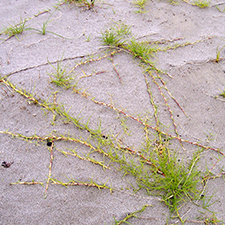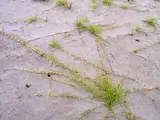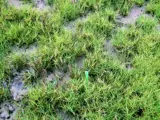 Saltwater paspalum
Saltwater paspalum
Common name: Saltwater paspalum
Botanical name: Paspalum vaginatum
Management programme: Advisory
Originally from the Americas it was introduced to New Zealand primarily as a turf grass for coastal golf courses. It is used in other parts of the world for erosion control, animal feed and as a turf grass, but its introduction to New Zealand has resulted in damage to coastal habitats, flora and fauna.
Why is it a pest?
- It can spread 1-2m per year, pushing out native plants and dominating the habitat.
- Significant threat to nesting areas of fairy tern.
- Can constrict and alter water movement which affects fish breeding.
- Extremely tolerant of saline habitats.
Where is it found?
- Multiple sites are scattered throughout Tauranga harbour.
- Likes to occupy margins of river mouths and estuaries – likes brackish water.
- Can grow in mud, shingle, shell, sand and in between boulders. Can spread to nearby pasture.
- Also happy amongst mangroves, shrubland, salt marsh and sand dunes.
- Spreads via root fragments, seeds and soil movement.
What does it look like?
- Stems can grow up to 80cm.
- Leaves are stiff, about 10-19cm long and usually blue-green in appearance.
What are the rules?
Advisory
Council does not enforce the control of advisory species. It is landowner/occupier responsibility to manage these pests. Council may provide advice on how to manage or control advisory species if required.
How do you get rid of it?
Foliar spray with a grass-specific herbicide
It’s recommended that follow up control is completed twice annually until all plants have disappeared. Continue control for the next several years to deal with re-growth from the stems that will still be viable underground.
Mechanical removal is not recommended due to the delicate nature of the environments this plant grows in and the risk of spreading fragments caught on machinery.
CAUTION: When using any herbicide or pesticide, PLEASE READ THE LABEL THOROUGHLY to ensure that all instructions and directions for the purchase, use and storage of the product, are followed and adhered to.
Read more on pest control advice, information and regulations.
Images


